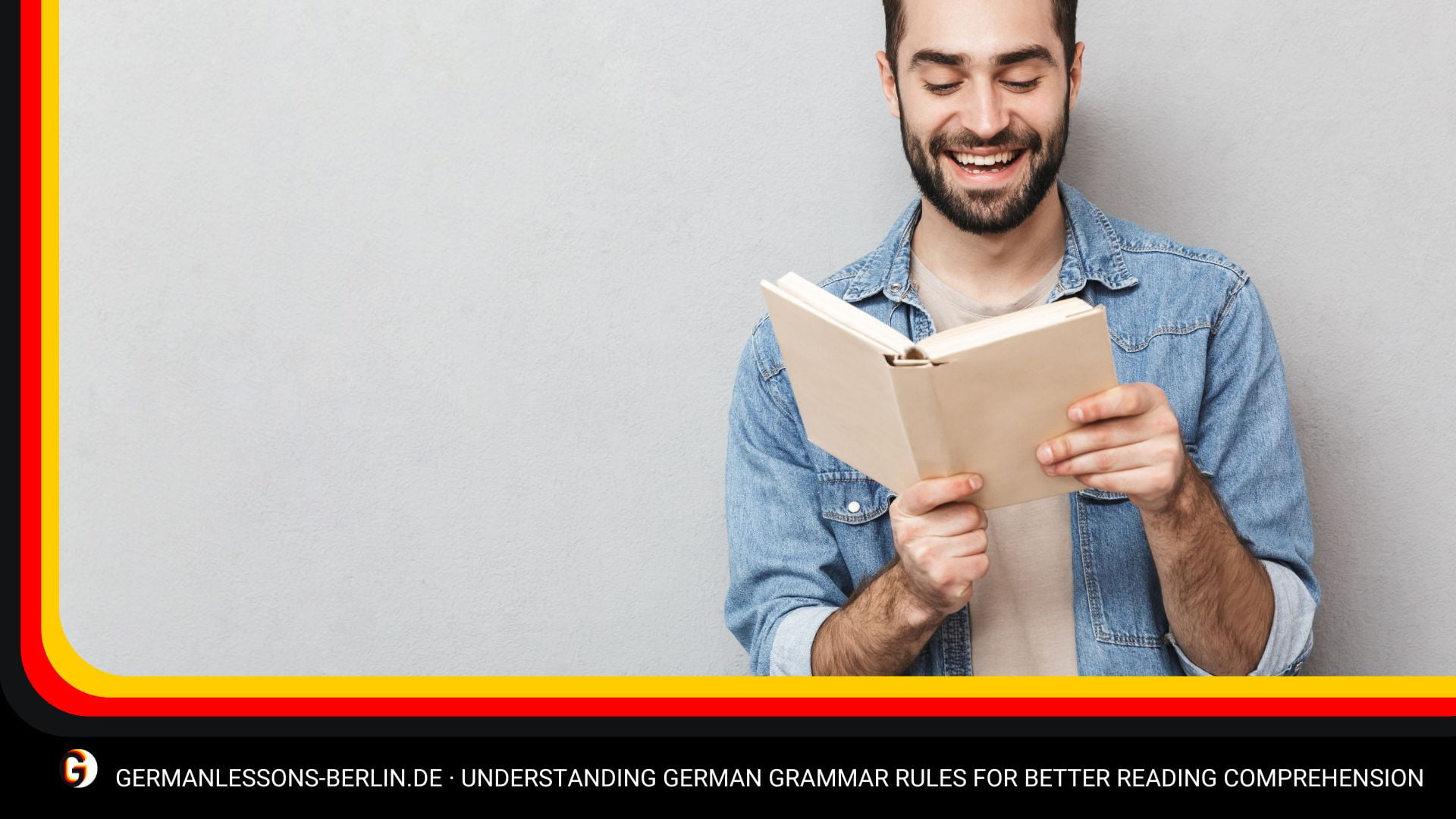Table of Contents
As a language enthusiast and advocate for cultural exploration, my venture into the rich tapestry of the German language has been nothing short of exhilarating. I’ve found that the key to unlocking the vast treasures of Germany’s literary heritage and daily communication lies within a solid grasp of German Grammar Rules for Reading Comprehension. It’s not an insurmountable fortress of irregular verbs and gendered nouns. Imagine it as a pensive game of chess where each strategic move enriches your understanding, opens up dialogues with native speakers, and enhances your appreciation of classics penned by Goethe and Schiller.
Consider this article your German Grammar Quick Reference Guide—a compass to navigate the intricacies of the German language. With effective German grammar tips and a user-friendly approach, we’ll demystify complexities and build your confidence, ensuring that when you read, you not only interpret words but also connect with the heartbeat of each sentence. Let the adventure begin!
Key Takeaways
- Grasp the basics of German grammar to enhance reading comprehension and confidently explore the language’s literature.
- Start with a positive mindset, viewing the learning process as a flexible and error-friendly journey.
- Utilize a German Grammar Quick Reference Guide to comprehend and apply rules effectively as you read.
- Approach German vocabulary and grammar incrementally, beginning with foundations and building towards complexity.
- Remember that comprehending German grammar involves patience and practice, similar to mastering any skill.
Embarking on the German Language Adventure: A Mindset for Success
When I first made up my mind to learn German grammar, it was with a mix of excitement and trepidation. However, I’ve since discovered that, like many things in life, the right mindset can make a world of difference. As I navigate through the nuances of German syntax and grammar, I remind myself that learning to properly read and understand a new language is as achievable as any other skill I’ve learned. With a strategic approach and a source of reliable German language reference materials, I know that even the most daunting aspects of the language can become second nature.
At the start, the complexities may seem overwhelming. German grammar with its cases, genders, and seemingly endless exceptions presents a formidable challenge to language learners. But I’ve learned to view these not as hurdles, but as part of a thrilling linguistic puzzle. I’ve found comfort in German grammar resources that offer structured learning paths from simple phrases to more complex literary texts. It’s not just about memorizing rules—it’s about understanding the language’s rhythm and flow.
With patience and practice, each new phrase I master becomes a stepping stone towards fluency.
Adopting a step-by-step approach has allowed me to ease into the language, building from the basics of German grammar, and gradually working up to more intricate structures in a pressure-free environment. Here’s what my experience has taught me:
- It’s crucial to set realistic expectations and not to get discouraged by initial challenges.
- Every mistake is a learning opportunity, and there’s no need for embarrassment.
- Consistent practice, at a comfortable pace, cements understanding far better than cramming.
- Using a variety of learning aids and German grammar resources enriches the experience and aids retention.
It’s not an overnight journey, but a rewarding adventure where every step forward opens up new horizons. Here is a glimpse at my strategy breakdown:
| Stage of Learning | Approach | Outcome |
|---|---|---|
| Understanding Grammar Basics | Utilizing online resources and reference guides to clarify rules | A solid foundation in the essential rules of German grammar |
| Building Vocabulary | Learning the most common German words and phrases | Ability to engage with basic texts and conversations |
| Applying Knowledge | Practicing regularly with varied materials | Increased confidence and a natural feel for sentence construction |
It’s with this organized yet flexible approach that I’ve embraced the voyage of learning German. Every day brings with it a wealth of knowledge and the sense that, piece by piece, I’m uncovering the beauty encoded within the German language. If you, too, are considering this journey, just know that a positive mindset is the key to unlocking the potential that German grammar holds for enhancing reading comprehension and connecting with an extraordinary linguistic heritage.
Decoding the German Alphabet and Perfecting Pronunciation
The journey into comprehending German starts at the very foundation—the German alphabet and its pronunciation. For me, understanding the subtleties of these elements was pivotal, as it’s not just about learning a sequence of letters but embracing the very essence of German communication.
Discovering the Special Characters in German
Diving into the world of German grammar unveils an intriguing feature: the special characters. These are not merely stylistic flourishes; they are integral to mastering not only German pronunciation but also the language’s unique personality. Including ä, ö, ü, and ß, these characters transform how words are spoken and understood, setting the stage for genuine linguistic immersion.
The advent of these special characters in German goes beyond a mere twist on familiar letters; they represent sounds that don’t have exact English equivalents. Here’s a brief introduction:
- ä (a-Umlaut): Resembles the ‘e’ in ‘bet’
- ö (o-Umlaut): Think of the ‘i’ in ‘girl’
- ü (u-Umlaut): Similar to the French ‘u’ or the ‘ee’ in ‘see’ with rounded lips
- ß (Eszett or sharp S): Pronounced like ‘ss’ in ‘kiss’, it never begins a word
Conquering Diphthongs and Digraphs for Accurate Pronunciation
German diphthongs, which are pairings of two vowels that produce one sound, and digraphs, combinations of two or more letters representing one phoneme, are paramount for the accurate articulation of words. I found that mastering these could significantly tighten my grasp on German pronunciation.
Here’s a personal cheat sheet I’ve come to rely on:
| Diphthongs / Digraphs | Example Sounds |
|---|---|
| ei / ai | Just like the ‘i’ in ‘kind’ |
| eu / äu | Think of the ‘oy’ in ‘boy’ |
| au | Resembles ‘ow’ in ‘how’ |
| ie | Long ‘ee’ as in ‘see’ |
| ch | ‘kh’ sound as in Scottish ‘loch’ |
| sch | Corresponds to English ‘sh’ |
An accurate pronunciation of these can make the difference between saying ‘beer’ (Bier) correctly or ending up with ‘bear’ (Bär). Such nuances underline the importance of learning diphthongs and digraphs early in the language acquisition process.
It’s the mastery of German pronunciation nuances that transforms mere words into a symphony of communication, setting the stage for richer dialogues.
I’ve learned that by wrapping my tongue around these special characters in German and the often perplexing diphthongs and digraphs, I’m not just reciting but actively thinking in German. This mental shift is essential for effectively decoding texts and engaging with the language on a deeper level.
So, if you’re aiming to excel in German, pay close attention to these significant aspects. Treat the German alphabet and its array of sounds as the introductory chords to the grand composition of the language. Your diligence in these initial steps of learning will surely echo throughout your journey to fluency.
Expanding Your Horizon with Basic German Vocabulary
When I embarked on my quest to learn German, I quickly realized that amassing a robust basic German vocabulary was like collecting the keys to unlock a treasure trove of new experiences. Knowing the most common words is indispensable since they appear repeatedly in everyday language and texts. I resorted to a German word frequency list, a practical tool that saved me time by focusing on words that Germans most often use, dramatically increasing my understanding of different contexts.
I’ve harnessed the power of flashcards, a time-tested method to memorize and retain the basic German vocabulary that I was learning. They turned out to be a game changer for me, making an otherwise herculean task into a manageable and even enjoyable one. Interestingly, by aligning my vocabulary learning with topics of personal interest, my enthusiasm for the language grew. This not only kept my motivation high but also helped me integrate these new words into my active vocabulary more swiftly and effectively.
With each new word I learned, another piece fell into place, providing a clearer picture of the German language landscape before me.
The digital age has unfolded yet another immersive option for language learning—virtual immersion programs. These innovative platforms have allowed me to interact with German in a dynamic environment, significantly enhancing my retention of vocabulary and deepening my comprehension skills.
- Repeating words and phrases aloud helped solidify pronunciation and understanding.
- Gaining exposure to words in various contexts made them stick better in my memory.
- Seeing words used in real life prepared me for their practical employment in conversations and readings.
The transformation has been astonishing. Words I once found alien and cumbersome now roll off my tongue with ease, and sentences I could hardly decipher are now windows into the thoughts and culture of their authors. For anyone learning German, I wholeheartedly recommend beginning with a word frequency list specific to your personal interests. And don’t underestimate the compounding effect of regular practice!
| My Personalized German Word Frequency List Structure | |
|---|---|
| Frequency Rank | Word/Phrase |
| 1-50 | Greetings, Basic Verbs, Key Nouns |
| 51-100 | Common Adjectives, Everyday Objects |
| 101-150 | Useful Adverbs, Descriptive Phrases |
| 151-200 | Basic Connectors, Question Words |
| 201-250 | Frequent Prepositions, Essential Conjunctions |
| 251-300 | Numbers, Days of the Week |
Through a stratified approach to acquiring new words based on their frequency, my conversational abilities and reading comprehension have greatly benefited. It’s been an embracing of the language in gradual, confident strides that has made me appreciate the nuances and depths of German, transforming my learning journey into a captivating endeavor filled with discovery and satisfaction.
Constructing Meaning: The Fundamentals of German Grammar
My journey into understanding German texts deeply is rooted in the foundation of German grammar rules. It quickly became clear to me that a firm grip on the intricacies of German sentence structure and syntax is indispensable. It isn’t merely about memorizing rules; it’s about internalizing a system that gives life to words, transforming them into carriers of rich, precise meaning.
Mastering German Sentence Structure for Clarity and Flow
One of my initial challenges was wrapping my mind around the flexibility and order of German sentences. Unlocking the pattern behind the positions of subjects, verbs, and objects in a sentence proved critical for reading comprehension. In my exploration, I learned that while English leans on a relatively fixed structure, German syntax affords a more fluid sequence dictated by an emphasis.
The beauty of German syntax lies in its balance of freedom and formality. For example, the presence of modal verbs alters sentence positioning, but the essence of meaning remains unscathed. This rhythm and flow within German syntax attracts those who value precision in language.
The Role of Gender and Cases in Shaping German Syntax
Mastery of noun genders and cases in German is not just an academic exercise; it’s a gateway to eloquence and nuance.
Early on, I realized that noun genders and the case system are the framework upon which German sentences are built. Knowing whether a noun is masculine, feminine, or neuter – along with the four cases – nominative, accusative, dative, or genitive – is like possessing a key to unlock sentence construction.
Each noun comes with a gender, making articles and adjective endings a well-orchestrated dance of grammatical agreement. The nominative case denotes the sentence subject, while the accusative identifies the direct object. Meanwhile, the dative and genitive cases enrich sentences with nuances, such as indirect objects and possession. Understanding these roles has been a crucial aspect of my progression.
Tackling Noun Plurality with Ease
English may add a simple -s or -es to form plurals, but German builds a plural panorama with various possibilities. Insights into noun genders and plural nouns offered me clues for their transformation, which isn’t always straightforward but follows its own coherent set of rules.
| Singular Noun | Plural Ending | Plural Noun |
|---|---|---|
| der Apfel (apple) | -äpfel | die Äpfel (apples) |
| die Blume (flower) | -n / -en | die Blumen (flowers) |
| das Buch (book) | -ücher | die Bücher (books) |
In my experience with pluralization, each noun category brings its own pattern, and memorizing key examples catalyzed my comprehension. For instance, many feminine nouns add an -en or -n, creating nuanced sound shifts that signify plurality. Identifying these patterns has made reading German texts less daunting and more intuitive for me.
Collectively, these core aspects of German grammar do not just serve as academic constructs. They are instrumental in delivering clear, impactful messages within the German language. And as I weave through the intricate tapestry of German syntax, noun genders, and plural nouns, I continue to build the framework essential in becoming a proficient reader. This exploration through a detailed German grammar guide has allowed me to connect more profoundly with the texts, and thus, become a part of the storied tradition of the German linguistic legacy.
Finding the Perfect Reading Materials for German Language Learners
As I ventured deeper into my German language learning odyssey, I discovered the significance of curating a collection of German reading materials tailored to my evolving skill level. Identifying resources suitable for beginners and incrementally challenging myself with more sophisticated prose has been instrumental in sharpening my comprehension abilities.
The journey started with simple texts. Like many other German language learners, I was initially swamped by the sharp turn from learning individual words and grammar rules to facing a full page of text written entirely in German. But this discomfort soon gave way to exhilaration as I found materials that bridged the gap between learning and application.
There’s a certain gratification that comes when you finish reading a paragraph, a page, or a story in German, and you realize that you’ve understood it all on your own.
These stepping stones of literary complexity have substantiated my language skills and amplified my linguistic self-assurance. It’s not just the variety of texts that supports this growth, but also a personal interest in the subject matter. Intertwining my language practice with topics I’m enthusiastic about has kept the flame of motivation burning bright.
The harmony of personal intrigue with content complexity leads to a sustainable growth path in language acquisition. Below is a structured approach to selecting reading materials, which has been crucial in my development as a reader in German:
- Starting with children’s books and fairy tales that employ a basic vocabulary and sentence structure.
- Graduating to everyday reading materials such as menus, catalogs, and simple online articles.
- Progressing to reading German news websites, wherein current events add to vocabulary related to politics, economy, and culture.
- Eventually delving into short stories and novels by celebrated German authors, which challenged my grasp on complex sentence structures and idiomatic expressions.
Here is a table that reflects my leveled approach for selecting reading materials through various stages of learning:
| Learning Stage | Reading Material | Focus Area |
|---|---|---|
| Beginner | Children’s books, Language learner’s stories | Simple vocabulary and structure |
| Elementary | Menus, Catalogs, Tourist Guides | Everyday language use |
| Intermediate | News Articles, Blogs, Simple Literature | Widening vocabulary, understanding context |
| Advanced | Classic Literature, Technical Texts | Complex structures, Idiomatic expressions |
The thoughtfully chosen reading materials act as rungs on the ladder towards fluency, each offering new challenges and opportunities for learning. It is the judicious selection of these materials, combined with a steadfast commitment to regular reading practice, that has edged me closer to my goal of mastering the beautiful complexity of the German language.
In conclusion, my experience underscores the importance of choosing German reading materials that are not only level-appropriate but also align with personal interests—a formula that has proven effective in sustaining engagement and fostering language growth for German language learners like myself.
Establish a Consistent Practice Routine for Reading German Texts
Embarking on the journey to practice German reading, I discovered that establishing a regular and structured reading routine was pivotal. Just as an athlete needs to train regularly to excel, I honed my proficiency in German by integrating diverse and frequent reading exercises into my daily schedule. Recognizing that language learning is akin to muscle memory, consistent involvement with German texts became the cornerstone of my improvement.
My routine consists of immersing myself in a variety of German writings, from newspaper articles to thematic blogs, each providing a unique angle and complexity to the language. This varied exposure to different text types and topics has been instrumental in reinforcing my vocabulary and grammar skills, contributing significantly to a well-rounded understanding.
Consistency in reading practice cultivates an intuitive grasp of German nuances, transforming rigid rules into fluid language mastery.
To encapsulate my approach, I crafted a personalized reading timetable, which includes:
- Dedicated reading moments each day of the week.
- A mix of fiction and non-fiction to engage different linguistic structures.
- Reading aloud sessions to reinforce pronunciation.
- Analytical pauses where I dissect complex sentences and grammar applications.
What’s rewarding is the progression I observe; from deciphering simple sentences to unpicking the intricate layers of a novel or a technical piece of writing, I witness my own linguistic evolution. This revelation motivates me to persist against the tides of linguistic challenges.
To illustrate my progress quantitatively, I monitor my comprehension levels in the following table, noting improvements and areas that need more focus:
| Week | Text Difficulty | Comprehension Level | Vocabulary Growth |
|---|---|---|---|
| 1-2 | Simple Articles | Basic Understanding | +50 Words |
| 3-4 | Intermediate Blogs | Moderate Competence | +70 Words |
| 5-6 | Advanced News | Considerable Insight | +100 Words |
| 7-8 | Scientific Texts | Complex Interpretation | +150 Words |
For those who share the ambition to delve into the depths of German literature and daily communication, remember that regular reading not only anchors new vocabulary but also unveils patterns and structures inherent in the language. This systematic approach, challenging yet incredibly rewarding, fosters a confident transition from learning rules to appreciating the fluidity of communication that lies within the realm of German texts.
Advancing to Complex German Texts with Confidence
As my proficiency with the German language deepens, I recognize a newfound courage to engage with complex German texts. With a firm foundation in grammar and vocabulary, I am primed to traverse the elaborate landscape of advanced reading material. It’s this phase of learning where true German reading comprehension takes flight, soaring through the eloquent intricacies of profound writings that challenge and expand the mind.
Fascination begins as simpler sentences give way to intricate expressions full of nuance. This transition isn’t simply a step up in difficulty; it’s a definitive leap into a world where each line of text offers a rich array of literary styles and a deeper dive into cultural nuances. Advanced texts are more than just words strung together—they are a tapestry woven with the threads of nuanced language and diverse storytelling techniques.
Venturing into this realm with confidence means trusting in one’s accumulated knowledge and employing it to dissect and comprehend the advanced grammatical structures and sophisticated vocabulary found within these works. I’ve come to cherish this part of my language journey, where reading becomes an intellectual banquet, feasting on ideas presented in thought-provoking and complex arrangements.
As the sentences weave a denser narrative, I am armed with the necessary skills to unravel their meanings and appreciate the majesty of written German.
Here’s a breakdown of the phases I’ve encountered on my path to conquering complex German texts:
- Transitioning from simple narratives to those with multiple plotlines and more abstract concepts.
- Diving into technical texts laden with industry-specific lexicon that challenges my contextual understanding.
- Delving into historical and philosophical treatises that test my comprehension of nuanced argumentation and rhetoric.
With each layered sentence and every page turned, there’s satisfaction in knowing that these complex texts offer a gateway to a broader comprehension of the German language and its cultural essence. This table outlines my strategic approach to incrementally increasing textual complexity:
| Text Type | Characteristic | Approach |
|---|---|---|
| Literary Works | Metaphorical language, varied sentence structures | Analyze themes and narrative style for context |
| Academic Articles | Technical vocabulary, Argumentative structure | Dissect arguments and familiarize with field-specific terms |
| Official Documents | Formal language, Bureaucratic jargon | Study syntax and legislative expressions for clarity |
The journey through complex German texts is both an academic endeavor and a source of joy; it encapsulates the essence of learning—embracing the unknown with eagerness and an open heart. As I look back at the progression from my first faltering words to my current immersion in sophisticated passages, I realize that confidence is not just a state of mind but a reflection of the hours of dedicated learning and practice devoted to one of the world’s richest languages.
Leveraging Diverse German Grammar Resources for Deeper Understanding
Navigating the waters of German grammar can be an enriching experience when armed with the right tools. My exploration of German grammar resources has provided me not only with the rules but the context in which to use them. Delving into the wealth of information available online, I’ve unearthed a multitude of Online German Grammar Guides which come replete with examples that simplify the often daunting task of mastering a new language.
Navigating Online German Grammar Guides
One of my first steps in reinforcing my grammar skills was utilizing Online German Grammar Guides. These guides are a treasure trove of detailed explanations, user-friendly exercises, and invaluable German grammar tips—all tailored to bolster one’s understanding of this linguistic framework. These resources, ranging from foundational principles to intricate rules, play a pivotal role in my learning process, helping me grasp the finer points of the language.
Here are a few of the key benefits I found while using online guides:
- Structured tutorials that walk you through grammar topics step by step.
- In-depth explanations that demystify complex concepts.
- Immediate practice exercises that reinforce new information.
- Accessible anytime, at my own pace, to suit my busy lifestyle.
Without these guides, my progress would have been slower and fraught with far more confusion. Instead, they’ve provided clarity and direction, making them an indispensable component of my study regimen.
Creating Personal Grammar References: Verb Books and Beyond
Another strategy that has proven effective for me is compiling personalized German verb books. This method involves categorizing verbs by their conjugation patterns, creating a quick-reference tool that I can turn to during my studies. The visual layout of a verb book helps me to quickly recall conjugation rules and apply them with confidence.
Additionally, the power of color-coding cannot be overstated. Applying different colors to various grammatical elements like verb positions, noun cases, or adjective endings has significantly boosted my memory retention. There’s something about the visual distinction that helps these rules stick in my mind.
Below is an example of how my verb book and color-coded notes add structure and visual appeal to my studies:
| Verb Category | Verb Conjugation Example | Colors Used |
|---|---|---|
| Regular Verbs | “spielen” (to play) – ich spiele, du spielst, er spielt | Green for endings |
| Irregular Verbs | “sehen” (to see) – ich sehe, du siehst, er sieht | Blue for stem changes |
| Separable Verbs | “anfangen” (to begin) – ich fange an, du fängst an, er fängt an | Orange for prefixes |
| Modal Verbs | “können” (can) – ich kann, du kannst, er kann | Purple for modality |
Implementing these color-coded aids in tandem with my verbal arsenal has streamlined my learning process, making the otherwise tedious task of grammar study far more engaging and effective.
A well-organized grammar reference, brimming with vibrant hues, transforms the mundanity of rote learning into an artist’s palette of grammatical expression.
The journey through the German language is enriched by leveraging the wealth of german grammar resources available to language learners. From assorted Online German Grammar Guides to the personalized flair of German verb books with a splash of color, these tools infuse my studies with vibrancy, making each lesson both informative and memorable. As I continue to navigate the contours of this language with these resources as my compass, I’m ever closer to achieving a profound understanding of its grammar’s inner workings.
Understanding Common Pitfalls and How to Avoid Them
Embarking on the quest to master German grammar rules can sometimes feel like navigating a labyrinth ripe with potential missteps, known as German language pitfalls. One encounters a terrain of complex cases, bewildering verb conjugations, and a profusion of rules for pluralizing nouns, each capable of tripping up even the most diligent language learner. As I plotted my course through this landscape, one core strategy emerged as paramount: deconstructing the maze of German grammar one piece at a time.
Initial forays into this realm revealed the case system as a notorious stumbling block. Fluent communication hinges on mastering this aspect of German grammar, and yet, the intricacies can seem as enigmatic as deciphering an ancient code. The accusative case, commonly the launch point for learners, can often disrupt a beginner’s stride. To counter this, I adopted the tactic of focusing solely on this aspect until the nuances were securely internalized.
Visual learning aids manifested as invaluable allies in this process. Color-coding, for instance, became my beacon through the fog of confusion.
By marking each case with a different hue, the abstract rules began to solidify into a tangible pattern, making their application in sentence construction feel almost second nature.
My toolkit expanded further as I created original sentences, coaxing the learned rules from the confines of rigid memory into the light of practical usage. This experiential learning reinforced my recall and understanding, turning once formidable grammar rules into familiar friends.
When faced with an esoteric rule or an unyielding conjugation, I found solace and enlightenment in a multitude of resources beyond the confines of my own studies. Reaching out for aid is not an admission of defeat; rather, it signifies a strategic pivot towards success.
Below is a concise table illustrating the strategies that proved most effective in surmounting German grammar hurdles:
| Grammar Challenge | Focus Area | Strategy Implemented |
|---|---|---|
| German Case System | Accusative Case Proficiency | Dedicated study sessions, repetitive practice |
| Verb Conjugation | Regular vs Irregular Verbs | Curated verb lists, drill exercises |
| Pluralization of Nouns | Identifying Patterns | Grouping nouns by pluralization rules |
These combined efforts—mindful focus on discreet grammar components, visual reinforcement through color-coding, application through sentence composition, and seeking clarification when needed—have paved my way towards a broader and more intuitive understanding of German. As you chart your own course, may you find these strategies as illuminating and transformative as I did, bringing you closer to the eloquence and precision embodied within the German language.
Adapting Your Learning Strategies to German Grammar Intricacies
As someone who has navigated the ebbs and flows of learning German grammar, I’ve come to respect and even admire its complexity. German grammar intricacies can initially appear daunting, but with tailored learning strategies, the language begins to unravel its mysteries, inviting learners into a world of enriched communication and profound understanding.
My journey began with a staunch belief that no rule was too convoluted and no exception too elusive. I invested in creating personalized tools — verb books and color-coded notes — that served not only as references but as visual maps charting my possession of the language’s grammar.
Adapting to the German cases, embracing noun genders, and conjugating verbs became less about memory work and more about recognizing patterns within the language tapestry.
Among the various grammar elements, I found that focusing on the accusative case was particularly beneficial. For instance, the accusative is used to mark direct objects, a pivotal aspect when constructing sentences. Nouns undergoing the actions are in the accusative case, which directly affects the articles and adjectives associated with them. It’s like solving the first piece of the puzzle that makes solving the rest simpler.
Another game-changer for me was incorporating the ‘time, manner, place’ principle for sentence construction, enabling me to build sentences with a more natural flow, reflective of the Germanic style.
- Time: When did it happen?
- Manner: How did it happen?
- Place: Where did it take place?
This sequence plays a critical role in the clarity and fluidity of expressing oneself in German, giving precedence to certain information within a sentence for emphasis and comprehension.
Extending my strategies, I delved into learning with flashcards, which proved to be an efficient method for constant revision and assessment of my growing vocabulary and understanding of grammar rules. Furthermore, I tuned into German programming, which put German grammar in context and honed my listening skills, an often-overlooked facet of reading comprehension.
Realizing that not one method alone would suffice, I amalgamated these tools and techniques into a custom regiment that fit my learning style. Reflecting on this, let me share a table that encapsulates my strategic approach to German grammar’s complexities:
| Learning Approach | Tools and Techniques | German Grammar Focus |
|---|---|---|
| Visual Aids | Color-Coding, Flashcards | Verb conjugations, Noun genders & cases |
| Practical Application | Verb Books, Example Sentences | Accusative case, Sentence structure |
| Contextual Learning | German Programming, Reading & Listening Exercises | Usage in real-life contexts, Conversational German |
| Structured Practice | Regular Revision Schedules, ‘Time, Manner, Place’ Sentence Building | Consolidating rules, Enhancing fluency |
By employing an array of learning strategies and tools, I was able to break down the barriers that German grammar intricacies initially posed. It was through this blend of visual, practical, contextual, and structured practices that I found a potent formula for surmounting the challenges and laying down a path toward mastering German grammar with confidence and efficiency.
Conclusion
The odyssey of mastering German grammar and enhancing reading comprehension in German unfolds like an intricate dance: step by careful step, we become more adept at navigating its rhythms. My own journey began with a resolve to face the complexities of German grammar with a poised and open mindset. Through diligent practice and exploration, I’ve discovered the transformative power of a structured approach. Starting with the concrete — the alphabet and pronunciation — I leveraged resources to build a robust vocabulary, eventually weaving these threads into a strong grammatical tapestry.
Mastering German grammar is akin to piecing together a puzzle; each grammatical concept is interconnected, unveiling a clear picture when viewed as a whole. As I transitioned from foundational elements to nuanced rules, my proficiency grew, reflected in the confidence with which I now dissect and comprehend substantive German texts. Regular practice routines have been paramount in this process, ensuring that my abilities in reading comprehension in German are not just fleeting insights but lasting skills.
In sum, my quest to master German grammar has been both rigorous and rewarding, requiring a commitment to perpetual learning and adaptation. With every linguistic hurdle overcome and each resource utilized, I’ve edged closer to true proficiency. As I continue to embrace the intricacies of German syntax and semantics, I am reminded that language learning is not just an academic pursuit but a journey that enriches the intellect and the soul.
FAQ
What are the foundational German Grammar Rules necessary for Reading Comprehension?
Key German grammar rules that travelers should familiarize themselves with include understanding noun genders and cases, verb conjugations, sentence structure, and pluralization of nouns. Grasping these concepts is essential for accurate reading comprehension.
How can I develop the right mindset to successfully learn German grammar?
Approach learning with a positive attitude, being patient with your progress, and setting realistic expectations. Understand that acquiring a new language is a gradual process, and consistency is key. Start with simple phrases and slowly build up to more complex texts.
What are the special characters in the German alphabet, and how do they influence pronunciation?
The German alphabet includes ä, ö, ü, and ß as special characters. These characters significantly impact how words are pronounced, and understanding them is crucial for reading German accurately.
Why is mastering diphthongs and digraphs important for German pronunciation?
Diphthongs and digraphs such as ‘ei’, ‘au’, ‘ch’, and ‘sch’ play a significant role in German pronunciation. Mastering them is important for developing accurate pronunciation, which in turn improves reading comprehension.
What are the best approaches to build basic German vocabulary?
Start with commonly used words from a frequency list and use flashcards or virtual immersion programs for retention. Incorporate vocabulary relevant to your interests to make learning more engaging.
How does German sentence structure differ from English, and why is it important?
German sentence structure is often more rigid, with a tendency to put the verb in the second position in main clauses. Understanding sentence structure is crucial for parsing sentences correctly and ensuring that your reading comprehension is on point.
How do noun genders and cases shape German syntax?
Noun genders (masculine, feminine, neuter) and cases (nominative, accusative, dative, genitive) affect article and adjective forms in German. This influences word order and sentence meaning, making it an essential aspect of German syntax.
What strategies can help with understanding the pluralization of German nouns?
Familiarize yourself with the most common plural endings and patterns. Practice with lists of nouns and use memory aids like flashcards to help recognize and apply pluralizing rules.
How can I find suitable reading materials for my level of German?
Look for beginner texts if you’re just starting out and gradually move to more complex materials such as newspapers, novels, and specialized articles as your skills improve. Always choose texts that align with your current comprehension abilities and interests.
Why is establishing a routine important for practicing German reading?
A consistent reading practice helps reinforce newly learned vocabulary and grammar, making them second nature. A routine also promotes exposure to the language and improves comprehensive skills over time.
How can I confidently advance to complex German texts?
Once comfortable with the basics, select texts just above your comfort level to challenge your comprehension gradually. Implement vocabulary and grammar knowledge in context and reflect on the text to build confidence.
What are some effective online German Grammar Guide features?
Effective online German grammar guides should offer clear explanations with examples, exercises for practice, and possibly interactive elements to test understanding. They also often include resources for specific topics like verb conjugations or case usage.
How can creating personalized grammar references aid my German studies?
Personal grammar references, such as verb books, can help you quickly review conjugation patterns and serve as a handy resource during practice. They can be customized to focus on areas you find challenging.
What are some common pitfalls in learning German, and how can I avoid them?
Common challenges include mastering the case system, verb conjugations, and noun pluralization. To overcome these, practice one grammatical aspect at a time, create visual aids like color-coded charts, and apply the rules by constructing sentences. Seeking clarification through additional resources is also helpful.
Can you suggest some adaptable learning strategies for the intricacies of German grammar?
Yes! Utilize a mix of methods such as flashcards, color-coding grammatical structures, focusing on key grammatical aspects like the accusative case, and applying these in context through sentence building or watching German media. The aim is to find strategies that resonate with your learning style and make the journey of mastering German grammar manageable and enjoyable.








